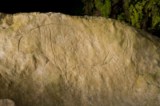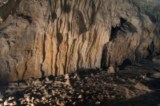|
PAPASIDERO - CALABRIA- SOUTH ITALY Papasidero lies
in a wild and coarse scenery between the mountains thickly overgrown with
woods and dotted with rocky peaks, close to the River Lao on the left and the
Santo Nocajo Torrent. It has the characteristics of a small medieval village
almost placed in a position to be hidden by possible attackers from sea.
The town hosts a prehistoric site named "Riparo del Romito" at a distance of 10 km from the town centre. This site features an art engraving of 10 thousand years B.C., that has been defined as "the most majestic and successful achievement of Mediterranean Palaeolithic Realism": a profile of a bull (bos primigenius 120 cm long and cm high) engraved on a rock wall of the "Grotta del Romito" (hermit's Grotto). The anatomic details of this engraving such as the eyes, nostrils, split hoofs, sexual organs, skin folds and horns curved backsets this to be one of the most ancient works of art performed by prehistoric man. The site has also given light to three couples of skeletons buried in upright position; fragments of glossy-black and reddish-grey crockery with coil shaped handles, animal remains, punches made out of bones engraved with geometric designs, and a further rock engraving of a mysterious weave of straight lines and curves who's significance has not yet been discovered. Papasidero puts up various churches: "Saint Theodore and Constantine", that houses a 17th century painting, "Saint Maria Odigitria", that keeps a 14th century Byzantine fresco, and "Saint Sophia" that also contains a large number of Byzantine style frescoes. These ministers where built by the people of the town who felt and lived two spiritualities: the Byzantine and the Roman Catholic and consecrated the churches to different Saints. |
||||||||





